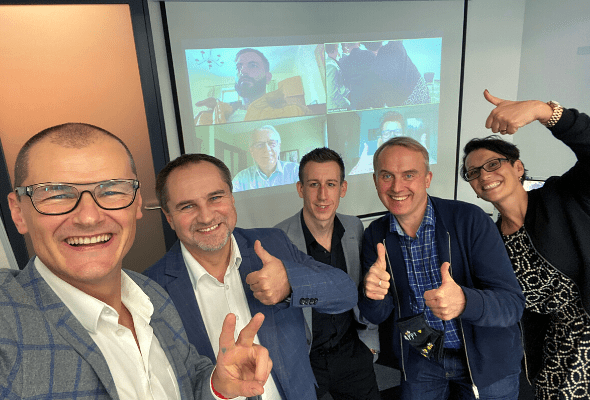
Hardly anyone remembers now, that the beginnings of the emergence of a modern method of management in factories – Lean Management and Lean Manufacturing – can be seen to have taken fruits as early as 1947 in Japan by William Edwards Deming and you can find his lectures, as early as the 1950s for Japanese engineers during that time. Is LEAN the most modern management method? Has technological progress, globalization, widespread access to knowledge, social media and companies based on cooperation economics caused LEAN management methods to become outdated and not as effective? For some, NO because they are constantly defending “good old” hierarchical structures, long-term implementations of LEAN and the presidents being forced to implement GEMBA. For some YES, because they notice how quickly the group of teal companies are expanding, based on flexible structures, self-organization, employee engagement and the company’s 100% use of an employee.
Have you not ever thought of throwing away the entire LEAN implementation? The constant explanation to new employees that when you say 5S, you are not talking about a smartphone model, that when you say you are going to do GEMBA you are not talking about a game and when you mention MUDA it is not mud that you are talking about or medusa. Don’t worry, you are not alone.
Fortunately, for consolation I will add: that you are not the first to abandon this complicated, Japanese cultured, long-term and self-disciplined process. Many people have done it before you, at least I have met many of them.
For the past several decades, a good alternative to LEAN has been created, more effective, more “human” and based on genuine human involvement and decisions made by co-workers.
Below I mention a few historical dates and people who contributed to the emergence of new management methods based on self-organization, internal employee motivation and leaving behind the formal hierarchical structures of organizations:
- In the beginning of the twentieth century, Merry Parker Follett, which Peter Drucker called „the prophet of management”, and her methods stood in opposition to Taylor’s methods of „command-and-control” and were based on interpersonal relationships, the search for win-win solutions and situational leadership.
- In 1949, Eric Trist – researcher of self-organization and group dynamics – together with his colleagues discovered a coal mine in Yorkshire which was self-organizing, highly autonomous and had highly responsible teams based on close contact of team members and their clients.
- During the 1950s and 1960s, Douglas McGregor noted that control demotivates a man and created Theory X and Theory Y describing two opposing approaches to managing organizations. He said: „Perhaps one day we should draw a new organizational chart as a series of interconnected groups rather than as a hierarchical structure of connected individuals.”
- In 1958 Bill and Vieve Gore founded W.L. Gore & Associates develop a family business that grew to 10,000 people who were innovative, freedom based, with high integrity and trust towards the organization. Decisions are made in a consultative way, employees are called associates and they choose a leader rather than have a traditional boss. The company has developed the concept of „job sculpting” – sculpting the position: „match the role to the co-worker, rather than the co-worker to the role”.
- In 1971, Dr. Jan Wallander joined Handelsbank, the largest bank of Sweden as CEO. He joined the company when the bank was going through a deep crisis and got a “carte blanche” for reorganizing the company. He eliminated the organizational structure and introduced a radical decentralization of the decision making method, without annual financial and strategic planning, and ensuring the independence for each of the bank’s branches.
- Ricardo Semler joined the Brazilian company Semco, founded by his grandfather, and in the 1980’s completely reorganized the company by introducing a democratic way of making decisions, abandoning the hierarchical pyramid, giving the teams autonomy to make decisions and transparency in finances, and employees wages were independently decided by employees themselves.
- Frank Blase in 1985 joined the small company igus GmbH, founded by his parents: Gunter and Margaret Blase, he decided to change the company’s organizational structure to the „solar system”. After the experience that he had working in a large corporation managed on the basis of a hierarchical pyramid, where many ideas were lost or undermined, in the decision-making process, passed from bottom to the top. He decided the client was the center of his organizational system and the teams are “orbiting” around the client – operating largely autonomously. Thanks to organizational and product innovativeness, the company quickly developed from a small German company into an industry leader with a total of 3,200 employees with 35 branches around the world.
- February 2001 the Agile Manifesto was signed by the most important programmers in the world. The Manifesto of Agile Software Development and which created foundations for a new way of organization in software development and companies based on close contact with the development team and with the client. Leaving behind the traditional roles of the boss and rigid organizational structures for agile organizations.
- In 2009, Brian Robertson founded Holacracy One. Based on his experience in managing an IT companies he strongly encourages new IT organizations to use self-organization, transparency and organizational agility.
- In 2010, Jurgen Apello published the Management 3.0 book, writing down his experience as a manager and management enthusiast, in which he writes how to organize a company without a hierarchical pyramid and departing from management methods based on „stick and carrot”.
- In 2014, Frederic Laloux publishes the book „Reinventing Organizations”, the Polish title „Work in a different way” in which he describes in detail 12 companies from various industries, different sizes, from different parts of the world, naming them teal organizations. All 12 companies described by Laloux are mentioned to be Teal. A method that strongly differs from traditional styles. In fact the 12 companies use a combination of completely different approaches to organizing and managing in new ways. The main differences that stand out in teal:
- Self-management: company counts on the ability of each person to self-organize, not the „command-and-control” system. These kinds of companies have no hierarchy in their organizational structure.
- Striving for fullness: moving away from the hierarchy and putting up masks, the „president” or „operator” is to be fully human with all aspects of humanity: emotional, physical, mental and spiritual.
- The evolutionary sense of existence: moving away from long-term planning, creating strategies for agility and organizational flexibility as well as seeking a team and individual sense of the existence of an organization and the humans involved.
The history mentioned above, of course, does not mention all practitioners, theoreticians and companies that use the “Teal” style of management. The history behind this story explains to a large extent why there are teal organizations and why we start to see more companies departing from management styles such as the „carrot and stick” and organizational structure based on a hierarchical pyramids. It is not a short-lived fashion but a lasting trend, proven in many industries, in many countries and there are more and more people in the world who start to understand this trend. Looking from a larger perspective, it turns out that there are still business entities, promises of companies in Poland and in the world, most often individuals, courageous presidents, business owners who are tired of constantly issuing new commands, tasks and being an enemy of their employees, the decision maker, inaccessible ruler, so in turn now they decided to switch their management methods to involve more participation, self-organization and being more of a mentor, colleagues and friend to their employees.
For 10 years, working, managing and co-creating igus in Poland, at the end of the year I decided to leave the company to start a teal organization; PerfectCircle from scratch and help other companies create more human jobs. Including participation in a management manner, supporting the CEOs and management boards in changing organizational structures. By creating PerfectCircle from scratch in a teal way, we also make sure to take care of the three pillars of teal organizations: self-organization, striving for fullness and the evolutionary sense of existence, I find this to be one of the best examples that you can start any company with a teal management style.
At the end I would like to honestly refer to the title of this article: I know the LEAN methodology because I also implemented it in igus and I know what are its pros and cons. I don’t think that the LEAN methodology is unnecessary for companies because many companies manage their everyday production processes based on these methods. In my personal opinion, if we did not have such people as William Edwards Deming or Taichi Ono, we would not be able to talk about teal organizations today.
However, being close and working as a coach of management boards with startups, IT companies and production plants from various industries, which are increasingly pushing for the teal management methods, I have one summary: let go of LEAN, go TEAL!
Author: Marek Wzorek

